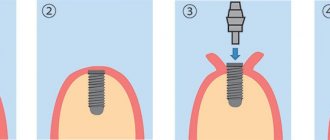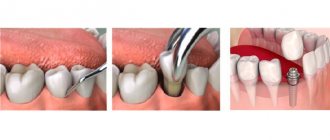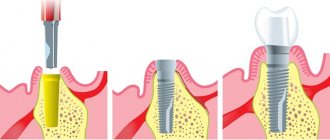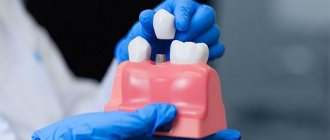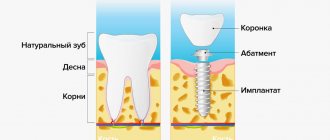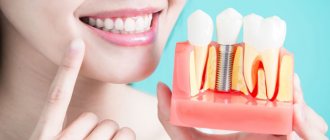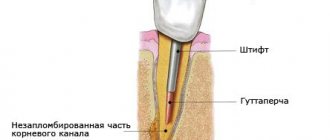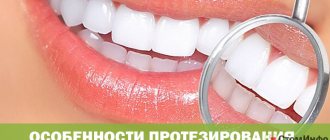When we go to the dentist, we hope that the pain will go away from our lives, if not forever, then for a long time. And indeed, for the most part, after eliminating the causes, many of us forget that they were once bothered by this or that tooth. But, unfortunately, this does not always happen. Sometimes a sealed tooth hurts when pressed, as if the canals were filled, but the tooth hurts, and then a logical question arises: can sealed teeth hurt?
Filling is a very complex and delicate process; any violation of technology or inattentive assessment of the situation can lead to extremely unpleasant consequences in the form of acute or aching pain, swelling of the gums, headaches, etc.
About the dental post
A dental pin is a structure made from a special impression. It is installed in a previously prepared root canal of the tooth. The pin is used as a support for dentures.
The pin is installed in the root canal of the tooth
It is worthwhile to dwell in more detail on the classification of rods that strengthen damaged teeth. Since there are a large number of pins and each of them has its own characteristics, it will be extremely important to understand and not get confused in all the diversity.
Remember ! Only the attending dentist decides which pin would be appropriate to use in each possible case.
First of all, there is a classification of pins according to the material from which they are made.
- Metal pins (also called anchor pins) are installed more often than others. Typically made from surgical steel, titanium, as well as platinum, gold and other various alloys.
- Carbon fiber is used as the material for the pins. Such rods are called elastic. Their characteristics are close to the natural dentin layer.
- Fiberglass posts are also very flexible and also have translucent properties - a big plus when placing them on the front teeth.
- Pins made of metal alloys with a polymer coating are called parapulpal. Usually they are installed not at the root of the tooth, but as a supporting structure.
- Another material for rods is gutta-percha. It is good for its environmental friendliness. Pins made from this material are much cheaper than others, but their service life is still shorter.
- Individual stump inlays. They are usually placed when the crown is completely destroyed.
There are several types of pins
There is also a classification based on the method of attachment to the tooth. According to it, the pins can be divided into:
- active pins - secured to threads for strength and durability;
- passive - installed in the tooth canal using a fixing solution. They do not last as long and are used for serious damage and expansion of the tooth canals.
According to the fastening method, pins can be divided into screw, cylindrical and conical.
There are also several types of pins according to the method of fastening
How much does prosthetics cost?
How much does it cost to put a pin in a tooth? The price of the rod depends on the material and manufacturing method. An ordinary metal one can cost 100 rubles, titanium or zirconium dioxide - from 1000 rubles. Remember that multi-rooted teeth will require several rods, and you will also have to pay extra for the preparation of the canals and for the crown. The total cost of prosthetics with metal-ceramics will be at least 10 thousand rubles, with ceramics – about 25 thousand.
Your questions and answers
QUESTION Hello, my front tooth is broken. The doctor says that we need to put a crown on a pin. Is it possible to just get by with a crown? Oleg
ANSWER Hello, Oleg. In this matter, it is still better to listen to the opinion of a specialist. If it had been possible to place a crown without using a pin, then they would have done so. Most likely, the tooth is very badly broken or has been frequently treated for caries or filled. The pin in this case will strengthen the tooth and allow it to support the crown longer. By the way, there is another and better option for replacing the pin - this is a stump tab.
Author: Vasin Yu. A. (Thank you for your help in writing the article and the information provided)
In what cases is a pin placed?
Dentists prescribe pin implantation when the crown is destroyed by more than 50%. In this way, the thinned walls are strengthened. The pin is also installed when building up stumps for artificial crowns.
In what situations is it not recommended to install a pin:
- the periodontium does not hold the tooth well;
- small root size;
- root caries damage
- the channel is perforated;
- cysts were diagnosed at the roots;
- for blood diseases;
- The walls of the tooth root are very thin.
There are situations when the installation of pins is contraindicated
Service life of a bridge
The period of operation of the bridge depends on several factors:
- What material is the prosthesis made of?
- Structure length;
- What condition are the supporting teeth in?
- Is the chewing load evenly distributed?
- Condition of periodontal tissues.
As a rule, the doctor guarantees the impeccable service of the prosthesis for five years. If you provide the structures with careful care and follow all the dentist’s recommendations, this period can be extended to 25 years.
Advantages and disadvantages
Positive aspects of the installation:
- a decaying tooth retains its shape;
- in the future, you can build up the tooth stump to install ceramic crowns;
- it becomes possible to restore the enamel;
- This way you can prevent tooth extraction;
- The pins are durable and should be replaced no earlier than every ten years.
There are many advantages to high-quality installation of pins
The disadvantages of this design include the following:
- the pin can become one of the causes of tooth decay;
- if the rod is installed incorrectly, it can cause caries;
- metal pins are susceptible to corrosion from external factors;
- allergies and pin rejection may occur;
- over time, the walls of the tooth become thinner, which leads to the subsequent removal of damaged teeth;
- installing a pin is a fairly expensive procedure, especially when using modern materials.
Unfortunately, there are also negative aspects to such a procedure.
Why does pain occur after installation?
The causes of pain with a pin installed cannot be identified on your own. If you notice that after implantation the tooth area begins to hurt, be sure to make an appointment with a doctor.
Pain occurs due to unprofessional or erroneous actions of the dentist.
- The pin is set too deep. The pain is felt during physical impact (for example, chewing) and has an aching character.
- During installation, the dental canal was cleaned with errors, and the walls of the tooth were damaged.
- The filling material has not completely filled the root canal. It could also simply extend beyond the apical foramen.
- When a fragment or several fragments are found in the canal belonging to endodontic instruments.
- In case of poorly performed disinfection of the canal during the procedure.
There are many reasons why pain occurs after insertion of a pin.
Important ! When installing the pin, the doctor requires high concentration.
During cleaning, it is necessary to use all the necessary instruments and identify the position of the apical foramen. To monitor the condition, an additional x-ray is prescribed.
In addition to incorrectly performed medical procedures, there may be other causes of painful sensations.
Normally, aching pain in a tooth can last up to several days; over time it subsides and disappears completely. Sometimes the pain is associated with an allergy, when the body does not accept the material from which the pin is made. In such cases, x-rays usually show the real picture.
Some discomfort after the procedure is normal.
If pain is not observed immediately after the intervention, but after a long period, for example, after several years, then the reasons that led to its occurrence may be as follows.
- Failure to maintain proper oral hygiene.
- Minor damage to tooth tissue (usually occurs due to biting nuts and other hard objects, opening lids with teeth, etc.).
- Periodontal inflammation.
- The appearance of cysts on the roots of teeth.
- Serious tissue damage.
Video - Dentist about pain in a tooth without a nerve
Possible complications
- severe pain, swelling;
- root fracture;
- restoration chips;
- the occurrence of a local allergic reaction to the material from which the rod is made;
- development of the inflammatory process (stomatitis, periodontitis);
- cyst development;
- fistula formation;
- mechanical damage to the walls of the tooth, which can lead to perforation of the root canals;
- splinters from dental instruments getting into the root canal.
It is important to know. The most dangerous complication is rejection of the installed supporting element by the body. In this case, it must be completely removed from the oral cavity.
Symptoms
Complications are expressed by the following symptoms.
- Pain due to external impact on the tooth (pressure or chewing) or eating too hot or cold food (has aching character).
- Swelling of the gums.
- Fever, nausea and weakness.
If the pin is not installed correctly, the person's condition may worsen greatly.
Important ! The latter symptoms may indicate the cause of complications after the installation of the pin - allergies.
Installing a pin is a good way to preserve tooth health for at least five to six years. Unfortunately, conventional fillings cannot completely solve the problem of serious damage to dental tissue. The pin installation procedure is painless, and using the latest generation materials can significantly reduce the likelihood of complications.
However, sometimes complications still arise. What could they be?
It was mentioned above that pain often occurs after implantation of the rod. Its reasons are different.
It happens that the dentist did not approach the process of installing the rod professionally enough. The reasons are:
- too deep implantation when the pin comes into contact with the bone;
- the walls of the teeth are damaged, the root canals are perforated;
- small amount of filling material;
- debris of dental instruments entering the tooth canal;
- acute pain may appear due to purulent formation, which leads to swelling of nearby tissues;
- if severe inflammation begins, this is fraught with the occurrence of fistulas due to the effect of purulent discharge on the mucous membranes and gums;
- if the patient has chronic periodontitis, there is a risk of cysts.
If the doctor does not install the pin properly, the patient will experience great discomfort.
Another common cause of pain after a pin is inserted is an allergy to the material from which the pin was made. Signs that the body does not perceive the structure well may include weakness combined with elevated body temperature, as well as inflammation in the oral cavity. Complications also arise when there is insufficient attention to hygiene procedures, for example, brushing the teeth and oral cavity.
There is a question: why does a tooth hurt if the nerve is removed?
Dentistry / Media about us / There is a question: why does a tooth hurt if the nerve is removed?
My name is Gogia Tea Zurabovna, I am a dentist-therapist at the SCNT “NOVOSTOM”. Many patients asked me the same question, so I decided to talk about it in detail.
Most people believe that if you remove the nerve from a tooth, it will never hurt again. What can hurt if the nerve is removed?
As soon as the patient catches a cold or simply freezes, such teeth begin to make themselves felt. Patients are surprised to learn at a dentist's appointment that the anxiety is caused by inflammation at the root of the tooth, and they need a new root canal treatment.
“I’ve already been treated for them!” they say: “What can hurt there if the nerve is removed? Without a nerve, a tooth is dead!” This is the most common misconception among patients, which leads to forced re-treatment.
It is important to know that if a tooth has been depulped, or, as we used to say, the nerve has been removed from it, this does not mean that this tooth will never hurt.
Pulpless teeth also need to be observed. There is a situation when, several years after removal of the nerve and treatment, inflammation may occur at the top of the tooth and treatment of periodontitis is necessary. It may not bother the patient, and he will not suspect it until an image is taken at a dentist’s appointment.
Or until, due to a decrease in immunity caused by a simple seasonal viral disease, the root inflammation worsens and the tooth becomes painful, causing trouble for the patient.
There can be several reasons for periodontitis:
- The main reason for the development may be poor-quality treatment of canals in the tooth: all root canals must be well processed and tightly sealed over the entire length. If the dentist missed the canal, did not remove the remains of the instrument, or allowed perforation of the canal, then this may subsequently cause an inflammatory process and root canal treatment will be required.
- However, periodontitis often develops with well-treated canals due to a large load, the so-called overload, on the tooth, caused by the anatomical features of the patient’s bite, when, due to injury, cracks, an allergic reaction to medications and toxins, the tightness of the tooth is broken and infection occurs.
Most often, microorganisms begin to multiply in the area of the root apex at the junction of bone and soft tissue. They release toxins, which leads to bone defects
, surrounding the tooth. This is exactly the case shown in the picture (Fig. 1 and Fig. 2).
It is for this reason that dentists recommend examining your teeth six months after treatment, and then taking an x-ray at least once a year for diagnostic purposes. It is important to know that at a certain frequency, which depends on the individual characteristics of the patient, and which should be checked with the treating dentist, it is necessary to take not only a targeted photograph and a panoramic photograph of the tooth of the previously treated tooth.
On OPTG Lower 3.6 teeth.
Spot shot of 3.6 teeth
For a more accurate diagnosis, it is also necessary to periodically do cone beam computed tomography (CBCT), which is usually abbreviated as CT. This technique improves the quality of diagnosis, often allowing you to avoid many errors in the process of treatment and diagnosis, and will not allow you to miss the moment of necessary treatment.
When conducting a study using CT, we get a 3D image that allows us to better study the condition of the patient’s jaws, viewing them on the screen in different projections. Thanks to dental CT, you can see each tooth not only from the front, but also from below, above, from the side, while rotating it at any angle.
Often, an inflammatory focus may not be visible on a targeted or panoramic photograph of a tooth: these are two-dimensional photographs, and the inflammatory focus may be covered by the tooth root or other structures.
The CT scan shows the same tooth as in the targeted image and in the OPTG.
Re-treatment of a tooth is especially difficult. No one can guarantee a 100% positive result during retreatment, since even with strict adherence to all treatment rules, the canal cannot be completely rid of microbes that have entered it. A lot depends on the patient’s body and its immunity.
Treatment methods used in modern dentistry help us to significantly reduce the likelihood of periodontitis: tooth isolation using a rubber dam, dental treatment under a microscope to process and study the anatomy of the tooth, good and high-quality medicinal and mechanical treatment of root canals.
By paying attention to all these points when choosing a clinic and a doctor, and not forgetting that the most important thing for your teeth is regular observation and good hygiene, you can make your visits to the dentist painless and enjoyable.
Source
How does the installation take place?
When preparing for the procedure, many patients wonder how exactly the intervention will take place. The complex of restorative actions is divided into two conventional stages - directly working with the pin and the process of restoring the tooth through prosthetics.
Important ! How the pin will be installed depends primarily on its type and material.
However, the procedure is usually unchanged. It must always be observed, no matter what teeth the pins are installed on: incisors, canines, molars or premolars.
How the pin is installed depends on many things
Accordingly, actions are performed in this order.
First of all, the patient is examined by a dentist. If concomitant conditions are discovered that may adversely affect the result, they must be pre-treated. Thus, you first need to cure caries and other pathologies of the oral cavity and teeth. In order to avoid complications caused by bacterial damage, professional sanitation of the oral cavity is performed.
An X-ray of the decayed tooth is also taken. Based on the information from the image, the dentist determines the characteristics of the tooth: length, angle of inclination and root diameter.
Next, the doctor determines which pin will be installed and how. On the appointed day before installing the rod, it is better not to eat food.
The intervention is carried out after the administration of local anesthesia: it is injected into the gum next to the damaged tooth. As soon as it begins to act, the procedure itself is carried out.
The intervention is performed under local anesthesia
The dental canals are thoroughly cleaned. To do this, drills are used, usually small in size, so as not to accidentally damage the canal and cause the formation of cracks and other damage. If necessary, expand the channel.
Interesting ! A filling is usually placed at the top of the root.
If a passive pin is installed, a cementing mixture is placed into the canal. A pin is placed in it, and it is thoroughly dried using a special dental lamp.
Next, the dentist conducts a control check and schedules the next appointment for further prosthetics.
The dentist himself sets the time for the next appointment
Is it necessary to remove a loose tooth?
In some situations this procedure cannot be avoided, but the main thing here is not to rush. Before drawing up a treatment plan, the dentist conducts an in-person diagnosis - examines the oral cavity, takes X-rays and studies the condition of the roots. The less damage is detected, the greater the chances of successful prosthetics. You won’t be able to do without deletion if:
- pronounced mobility;
- the infectious process is severely advanced.
At the same time, patients at dental clinics should understand that doctors are doing everything possible to maintain the integrity of their bite. Therefore, it is important to trust your doctor and strictly follow all his instructions. This approach will allow you to get excellent results in a short time.
How to build teeth onto pins, what is this process?
Prosthetics are performed after the pin is installed. Nowadays in dentistry, modern materials are used to make prosthetics; crowns are installed, as well as bridge prostheses if several teeth have been damaged at once.
First, the doctor must shape the filling material into the tooth around the post. It is shaped, filed and polished. What the result will be depends primarily on the experience of the dentist who works with this problem.
If the tooth is seriously damaged, a crown is installed. It is a special prosthesis that cannot be removed and is performed individually for each patient. Usually the cost of crowns is quite high.
If the tooth is seriously damaged, a crown is installed
The entire prosthesis imitates a damaged tooth. It is fixed on the pin using a special strengthening solution. After the crown is installed, some time must pass. Then the doctor checks whether her body rejects it or not. Implantation is considered successful if the prosthesis is installed tightly and there are no signs of inflammation.
When all your teeth are loose – what to do?
In cases where there is mobility of almost all the teeth in the mouth, it is necessary to urgently contact a dentist so as not to lose them. A comprehensive examination will help identify the cause of mobility and, if possible, eliminate it. To limit mobility and prevent further loosening and loss of teeth, the dentist will perform splinting. Further treatment tactics will depend on the cause of mobility and its degree - most often such mobility is provoked by periodontitis or periodontal disease, so it is necessary to eliminate these diseases whenever possible.
It also happens that the lower front teeth become loose, what to do in such a situation? Find out whether the patient suffers from bruxism (uncontrollable grinding of teeth during sleep), since this pathology can cause just such mobility.
Pain on pressure
Sometimes, with external mechanical influence (chewing, pressure), a feeling of pain may occur. This happens quite often, since the treatment process is quite complex, an artificial crown is installed. After some time, the pain goes away.
Another reason that causes pain when pressure is placed on a tooth is when the filling is placed too high. As a result, the jaw stops closing normally. Most often, pain of this nature occurs when chewing food. For prevention, it is recommended to remain under observation in the hospital for some time to understand whether there are any new unpleasant sensations after the intervention.
Sometimes after installing the pin, if you put pressure on the tooth, you can feel pain
The most common questions about pins and answers to them
Is it always possible to get by with a pin?
Unfortunately no. In case of significant tooth decay, when there is a risk of further destruction of the coronal part, dental prosthetics are recommended.
How to care for your teeth after having a pin installed?
For two weeks, it is not advisable to eat too hard food and use toothpicks. When brushing your teeth, you need to be as careful as possible so as not to injure your gums.
Is there an alternative to a dental post?
Yes, you can install a stump tab instead. This is a microprosthesis, the lower part of which is fixed into the root canals, and the upper part serves as a supporting element for an artificial crown.
Other causes of pain
One of the common causes of pain is the development of inflammation. This process begins approximately 1-2 days after the pin is installed and may indicate that the soft tissue was damaged during the procedure and became infected. In the oral cavity, infection occurs quite quickly, so you should not postpone a visit to the doctor for treatment - this is fraught with complications.
There is also such a thing as congenital tooth sensitivity. Usually the patient is aware of this peculiarity. Pain occurs, for example, due to chewing hard food or when eating food that has a contrasting temperature (very cold or hot).
Interesting ! The pain occurs due to congenital sensitivity of the teeth.
If the pin falls out
There are situations when the pin, together with the crown or filling made for it, falls out of the tooth cavity. In most cases, this situation is a consequence of medical errors at the stage of diagnosis or treatment. Reasons for unfixing may be:
- Incorrect determination of indications for pin installation;
- Poor quality fixation;
- Incorrect ratio of the length of the pin and the crown of the tooth;
- Incorrectly adjusted occlusal contacts.
Unfortunately, it is under no circumstances possible to fix the fallen structure back. In such cases, the tooth requires re-treatment, possibly using other methods of restoring the coronal part.
Restoring a tooth using a pin is an inexpensive and relatively quick option for prosthetics of a damaged tooth crown. It allows you to completely restore the lost function of the tooth, as well as achieve high aesthetic values. Since this is not only medical, but also aesthetic dentistry.
Ways to get rid of pain
Under no circumstances should you delay a visit to the doctor if you experience prolonged or progressive pain after installing the pin. The doctor will conduct a full examination, determine the cause and prescribe appropriate therapy. Usually, fluoridation of tooth enamel or building up a layer of enamel using filling material is prescribed.
Fluoridation of tooth enamel
If the examination shows that everything is in order with the installation of the pin, and the pain occurs on a tooth that is devoid of a nerve, most likely the cause is congenital sensitivity. The patient can cope with it independently, using a special toothpaste with a high content of calcium and fluoride. It is also recommended to use dental floss to remove food debris that causes discomfort and irritation.
When installing a dental pin, it is recommended to rinse your mouth with soda. For about three days, mechanical influences on the tooth from the outside are prohibited; you cannot touch it while chewing. You can take analgesics and apply cold compresses to relieve pain after the procedure.
It is recommended to rinse your mouth with baking soda
How long does it take to install a pin and how painful is this process?
The duration of the procedure directly depends on the initial condition of the oral cavity. If there are no problems, the pin is placed in one visit to the dentist. If periodontal diseases and other pathologies are present, a pin will be installed in the tooth root only after they have been eliminated.
Since the doctor touches soft tissue during the implantation of the supporting element, the procedure is often accompanied by painful sensations. The occurrence of pain after nerve removal is a natural process. But if a long-depulped tooth hurts, it is possible that the rod has entered too deeply into the canal. X-rays will help identify the cause of the pain.
Removing a dental post
The pin is removed in the following situations:
- if the apical part of the root becomes inflamed;
- when a filling needs to be replaced;
- during the preparatory stage before implantation;
- with unprofessional and poor-quality installation of the pin.
Removal of the pin is carried out in several stages. First, old fillings, crowns and other structures installed earlier are removed. Then, using ultrasound, the cement holding the pin is destroyed.
After this, you can directly remove the pin using forceps.
Important! If the pin is very firmly fixed in the root canal of the tooth, then ultrasound treatment is performed - due to vibrations, the pin moves, and this makes it easy to remove it.
After the procedure is completed, the doctor must check the patency of the root canals.
The doctor will definitely check if everything is in order after the procedure.
The pins are removed painlessly; this procedure does not pose any danger to the patient. Even anesthesia is not used in this case - only vibration and light pressure are felt.
Titanium pin in tooth
The pins located in the tooth canals can be made of titanium, but they should not be confused with implants. Dental pins belong to endodontics and partly to orthopedics, while implantation is a separate area. When a titanium pin is placed in an extracted tooth, the product is called an “implant.” This is an artificial root that is implanted in place of a lost tooth. Theoretically, a dental implant can be called a titanium post (which many people often do), but compared to classic posts, it performs a completely different function. The advantages of implantation today are undeniable: if a natural tooth is lost, it is the implant that can best restore its functionality and aesthetics.
After installing a dental post
As we have already noted, after a rod has been installed or a crown has been built up, pain is normal for some time. Usually this condition goes away after three days.
However, if you notice that the pain lasts longer or does not subside, but only intensifies, you should immediately visit a dentist. This may indicate damage to the roots of the teeth or the pin being installed too deeply when it comes into direct contact with the bone tissue. The cause can only be determined using an x-ray.
If the pain does not go away for more than three days, you should consult a doctor.
Important! Some patients may be allergic to the material from which the pin is made - then we are talking about symptoms such as redness or swelling. This condition should not be neglected under any circumstances; complications such as serious inflammation - stomatitis or periodontitis - may occur.
After the pin is installed, the patient is recommended to follow a certain regimen to help him recover faster after the intervention. These recommendations should be followed for approximately two weeks.
- Give preference to soft foods to avoid stress on your teeth.
- The toothbrush should be replaced with one with the softest bristles.
- The first time after installing the pin, you should not use electric toothbrushes, toothpicks or dental floss in the area of the tooth where the rod is installed.
- Smoking should be avoided for at least one day after the pin is installed.
- Regularly use a mouth rinse solution prescribed by a specialist.
- Physical activity is minimized or eliminated completely.
- You must strictly adhere to the treatment prescribed by your dentist.
It is important to follow your dentist's recommendations
To prevent and strengthen the immune system, immunostimulants, for example, Imudon, are often prescribed before and after intervention. This drug has proven itself as a means of strengthening local immunity and protecting against infections and inflammation after the procedure.
"Imudon" is indicated for use by children over three years of age and adults. It has a convenient form of administration - these are lozenges with mint flavor.
"Imudon"
What will the doctor do?
If the dental bridge is loose but not damaged, the dentist:
- Remove the prosthesis;
- If necessary, perform dental treatment;
- Reinstall the structure, securing it with fresh cement.
If the denture breaks, the dentist will install a new one.
To make the right decision, you need to know the exact reason. To do this you will need:
- Carry out a detailed inspection;
- Find out how long the structure will be used;
- What sensations does the patient experience?
- Take an x-ray of the supporting teeth.
Let's sum it up
Pain after insertion of a pin occurs for various reasons, but moderate pain is normal. The maximum time through which they must pass is up to five days. If the pain lingers for a longer period of time, it is necessary to consult a doctor who will find out what caused the pain.
However, if erroneous and unprofessional actions of the dentist were noticed, which include installing the rod too deeply, non-compliance with the rules for filling the root canals, damage to them with dental instruments, an incorrectly fixed pin and pieces of dental instruments accidentally left in the canal, then the pain is usually very intense and you need to get rid of it only after consulting a doctor.
Loose teeth - risk group
Loose teeth often occur in older people and pregnant women. In this case, this is a concomitant feature of the physical condition. To prevent loose teeth, older people and pregnant women need to consume dairy products (kefir, cottage cheese), more fruits, vegetables and berries. Make an appointment with a specialist doctor to prescribe calcium supplements.
Smokers are at particular risk for loose teeth. Harmful toxins released when smoking greatly weaken the protective functions of the gums. According to statistics, the teeth of smokers become loose twenty-five percent more often than the teeth of non-smokers.
Have you noticed that your tooth is loose? Do you feel an unpleasant taste of blood after eating solid foods? Contact your dentist immediately! If you are in the eastern district of Moscow, come to us! Your consultation with a doctor will be free of charge.
